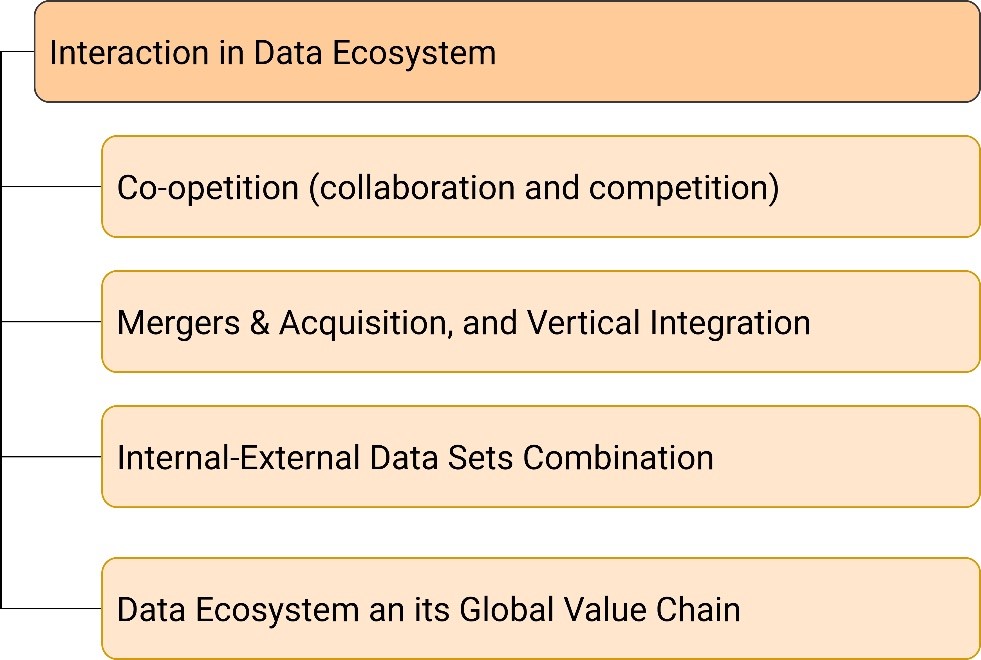Presenter : Radhitiya Al Furqan
Date : May 26th 2022
Part presented : Chapter 2, pg. 82-98
Presentation
The outline of the presentation consists of two main parts:
- Key actors in the data ecosystem
- Interaction in the data ecosystem
The key actor material is the continuation from previous week part. Previously, the actors discussed are Internet Service Providers (ISP) and IT Infrastructure Providers. On this presentation, actors being discussed including Data Providers, Analytic Service Providers, and Data-driven Entrepreneurs.
Key actors in the data ecosystem
- Data service providers
Consists of data broker, public sector, and individuals (consumers). Data broker’s core business rotates on collection and the aggregation of data. The market segment covers the B2B some B2C market segment. The revenue scenario comes from pay-per-use, licensing, or freemium (subscription). Some examples of data broker are Bloomberg, Nielsen, and World Weather Online. Public sector revolves around government as data provider. OECD PSI recommends that data provided by public sector should be free of charge. Lastly, individuals as data providers work when the data are provided by the user/consumers themselves. The example for this type of data provider is Waze (navigation apps) and the revenue model is the free services for the consumers.
- Analytic service providers
The basic role of this actor is to provide data analysis service with the revenue model of service contract. The needs of data analysis increase due to the requirement of real-time insight and the competitive differentiation. One unique point in analytic service providers is the existence of data crowdsourcing, where it makes possible to perform data analysis from by different users at the same time using cloud computing, e.g. Kaggle.
- Data driven entrepreneurs
It consists of two types of entrepreneurs, data explorers and data generating platforms. The data explorer provides goods and services based on the collected data, e.g. gild, dealangel. On the other hand, data generating platforms provide goods and services to generate data in order to enhance user experience and additional service, e.g. facebook, dupont pioneer.
Interactions in the data ecosystem

- Co-opetition
It stands for collaboration and competition. This interaction exist due to the multidisciplinary characteristic of big data. The example for this interaction is in the Hadoop ecosystem where lot of data providers collaborates for data sharing and analysis, but at the same time competing by improving their own products.
- Mergers and acquisitions, and vertical integration
Mergers and acquisitions involve two or more companies converted into one company or join under certain company. On the other hand, vertical integration involves the expansion of certain business activity which previously was done by relying on third parties.
- Internal-external data sets combination
This interaction focuses on the combination of databases from various department and processes. Data become more valuable when it can be shared and linked with other datasets. However, the value of data is context-dependent and lies in the combination of both internal and external data. In larger context, this interaction is expected to reveal additional insights.
- Data ecosystem and its global value chain
Data ecosystem relies on technologies and resource distribution, hence it possible to captured the data movements in international trade and global value chain.
Discussion 1: As data are being treated as commodity, what do you think about the possibility of data monopoly?
This question came up because of the key actors in data ecosystem actually performing economic activities by using data as the object, e.g. buying and selling data. We discussed about the high possibility of data monopoly where an owner of a data can put whatever price he/she wants on the data. One example for this is the service provided by Statista where you need to pay to access the data you want. We also discuss about future possibility of setting the standard price valuation of data.
Discussion 2: How do consumers (data buyer) evaluate the credibility of data provided by seller?
This question came up with the high traffic of data sell and purchase considering the existence of actors and interaction between actors in data ecosystem. Considering the position of buyer, data credibility is critically important as it will be used for decision making on the further steps. Taro suggested that one way to assess the credibility of data is by considering who provides the data. Reputable data provider considered to provides more credible data. Other method is cross checking the data from other sources. However, this method is difficult to apply considering the monopoly of data.
Discussion 3: What do you think about the possibility of informal practices?
This question was raised due to the activity of data broker that collects and aggregates data. Pere mentioned about company like Bloomberg that has people to go all over the internet to collect and aggregate data. It opens the possibility for freelancer (informal basis) to perform the data collection and aggregation without needing any formal contract basis.